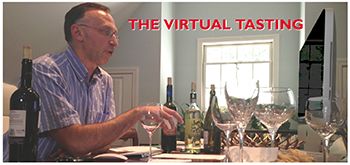THE VIRTUAL TASTING
WINE PUBLICIST Elizabeth Kane Tate of Ekt Communications organized an “intimate” wine tasting in a new setting via Skype. Tate’s email invitations (not e-vites) hinted that this novel venture will become a practical standard in wine-marketing and communication. The wines were real, the tasting conducted communally via long-distance. Tate’s invitation prompted your luddite reporter to get off his nickel and sign up for the new tool’s entry-level (free) version. It proved neither difficult nor costly to do so.
The one hour skype-tasting took place – well after lunch – on Tuesday, June 4. It was hosted by Julius Angelini, co-owner of Angelini Estate Winery and Angelini Wine Imports, headquartered in Centerbrook, Connecticut. As this is still a relatively new concept, it was decided to keep the flight to four bottles. The virtual tasting featured four Italian varietals imported by Angelini that are handled by Classic and Ruby in Massachusetts. Tasters were shipped 75Oml sample bottles ten days in advance.
Wine-skype participants were Becky Sue Epstein (Intermezzo), Kate Lavin (Wines and Vines) and Dina Cheney, cookbook author and “Taste Test” writer for EVERYDAY WITH RACHAEL RAY. Angelini guided us through the wines, one of them his family vineyard’s indigenous light red from Le Marche and all of them his imports. He answered a few questions in real-time and offered an email address for quick reading and response during the session. He was easily led off onto interesting tangents, such as winery ventures, Brunello integrity and an ad-hoc discussion regarding narrow corks versus sub-gauge bottles.
During the tasting, which began punctually and ended in the promised hour, we can see Julius, and he sees each of us, but we can’t all see each other. My camera showed only one of the four participating locales (actually a group of four sharing the wines); apparently some of the host’s cameras were in lock-down. Delays in speech, as often the case in remote transmissions, meant occasionally stepping on each other’s words. A little hesitant courtesy prevailed. When two of us voiced having a hard time extracting the Vernaccia cork, Julius promptly showed his ‘fail-safe’ waiter’s corkscrew with its double, not single, hook.
There was never really a discussion on the wines’ aromas and flavors, for at least two reasons: Angelini was quite comfortable expressing his own views, and one or two of us tasters monopolized much airtime with assertions, preferences, asides, and questions. Wine-skyping, as internet business meeting veterans will attest, does permit attendees to lurk silently, rather than jump into the fray.
Variables for readers considering conducting wine-skypes are that tasters control de facto their samples regarding serving temperature, glassware, length of time opened, and the like. Detailed instructions, in the sample box and/or by email, could help enforce quality control. In this case, each wine’s back label conveniently recommended serving temperatures: whites at 55°, Pergola at 62°, Cannonau at 68°. For my part, I chilled all four in the fridge, but removed the Cannonau two hours before the event and the Pergola one hour. I’d opened the whites the previous evening to write preliminary notes.
SKYPE-HOST COMMENTS
Angelini introduced himself as a winery owner and importer that does not sell retail. The winery was started in 1986 with his brother in the family’s ancestral Marche region, north of Verdicchio near Bologna. The farm overlooks the Adriatic Sea its 2OO acres planted only with eight acres of Sangiovese Grosso, Pergola and Merlot.
Angelini noted that the Pergola grape is related possibly to Aleatico, Lacrima di Moro or Garnacha. A recent (2OO6) DOC for a red grape known in The Marches as “Vernaccia” which is legally disallowed. Since it cannot be called “Vernaccia Rosso” it was finally named after the town. San Lorenzo is the home vineyard, both mom and dad born there or nearby.
The distribution and import house in Connecticut ships to 19 states and is still expanding its network. They look for wines with true varietal character, even on the “rustic” side, especially Brunello and Amarone, mostly from small producers farming 3 to 2O hectares. Exceptions are Livon (Fruili producer of quality Pinot Grigio, 5Oha), a few cooperatives and Prosecco pioneer Carpene Malvolti.
Angelini rightly emphasized food pairings for each wine, in some cases echoing the back labels of the bottles tasted. He also interjected diverting comments and facts, such as the longevity of Sardinians, a populace who drink their fair share of resveratrol-rich Cannonau.
TASTING NOTES By color; nose; flavor; texture; and finish.
Battistina Gavi 2O12
Pale gold/green; neutral Anjou pear, dry fruit and mineral (limestone?); pleasant, if somewhat mouth-drying. Next day: aromas diminished, finish less dry, with a touch of silk. $16.99 Ruby
Palagetto Vernaccia 2O12 Pale greenish; initially sweet nose of green apple and alpine flowers; tart, extra dry, puckery and astringent; a bit harsh, suggesting excessive SO2. [That sulfur whiff blew off by tasting time.] $12.99 Ruby
Angelini Estate Pergola Rosso (NV)
Light purple; quite perfumey with lavender, strawberry and clove; lightly volatile like gamay; medium-light body but leggy with glycerine; mouthfulling, pleasantly assertive; fruity finish. Next day: little flavor lost. Unusual! $16.99 Classic
Zanatta Cannonau 2O11
Clean garnet; cool, smooth fruited nose; hot in mouth, slightly overripe fruit; not heavy, but leggy with glycerine; clean, simple finish. $15.99 Ruby

